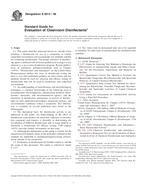Potrebujeme váš súhlas na využitie jednotlivých dát, aby sa vám okrem iného mohli ukazovať informácie týkajúce sa vašich záujmov. Súhlas udelíte kliknutím na tlačidlo „OK“.
ASTM E2614-08
Standard Guide for Evaluation of Cleanroom Disinfectants
Automaticky preložený názov:
Štandardné Príručka pre hodnotenie čistých priestorov Dezinfekčné
NORMA vydaná dňa 1.4.2008
Informácie o norme:
Označenie normy: ASTM E2614-08
Poznámka: NEPLATNÁ
Dátum vydania normy: 1.4.2008
Kód tovaru: NS-45730
Počet strán: 5
Približná hmotnosť: 15 g (0.03 libier)
Krajina: Americká technická norma
Kategória: Technické normy ASTM
Anotácia textu normy ASTM E2614-08 :
Keywords:
carrier tests, cleanroom, disinfectant, disinfectant qualification, efficacy, in situ testing, suspension tests, ICS Number Code 13.040.35 (Cleanrooms and associated controlled environments)
Doplňujúce informácie
| Significance and Use | ||||||
|
Requirements for aseptic processing areas include readily cleanable floors, walls, and ceilings that have smooth, non-porous surfaces; particulate, temperature, and humidity controls; and cleaning and disinfecting procedures to produce and maintain aseptic conditions. These conditions combined with careful and thorough evaluation of the chemical agents used for the cleaning and disinfection program should lead to achieving the specified cleanliness standards and control of microbial contamination of products. In recent years, the use of disinfectants in pharmaceutical, biotechnology, medical device facilities, and associated controlled environments has been the subject of scrutiny by regulatory agencies. An effective cleaning and disinfection program in aseptic processing areas of a Good Manufacturing Practice (GMP) facility is critical to assure the quality of the products. Manufacturers are being held to a high standard when it comes to product sterility and regulatory agencies are increasingly asking for validation data to support sanitization and disinfection procedures. Regulatory authorities now expect evidence of the efficacy of disinfection agents against environmental isolates. The FDA Guideline for Aseptic Processing states, “the suitability, efficacy, and limitations of disinfecting agents and procedures should be assessed. The effectiveness of these disinfectants and procedures should be measured by their ability to ensure that potential contaminants are adequately removed from surfaces.”6 Basic knowledge regarding the effectiveness of different chemical agents against vegetative bacteria, fungi, and spores will aid in selecting chemical agents. A good understanding of test methods used to assess disinfectant effectiveness is important. Most methods are adaptable allowing the user to customize the methods to their specific requirements. |
||||||
| 1. Scope | ||||||
|
1.1 This guide identifies important factors to consider when selecting a disinfectant for use in a cleanroom or similar controlled environment and recommends test methods suitable for evaluating disinfectants. The proper selection of disinfecting agents combined with in-house qualification testing is a key element to a successful disinfection program. Recent publications of regulatory guidance/standards such as Chapter <1072>, “Disinfectants and Antiseptics” in the United States Pharmacopoeia address the issue of disinfectant testing but there is very little published guidance on what criteria and test methods should be used for selection and efficacy testing of disinfectants that will be used in cleanrooms and controlled environments. 1.2 An understanding of microbiology and microbiological techniques is essential. Knowledge in the following areas is recommended: microorganisms, antimicrobial products (disinfectants, sporicides, and decontamination agents), and the chemistry of disinfection, mechanism of activity of disinfectants on cells, application procedures, cleanroom surfaces, and environmental conditions within a cleanroom. This information is available in several published texts listed in the bibliography. 1.3 The theoretical basis for disinfectant activity is not addressed in this guide. An understanding of the effect of disinfectant concentration on microbial reduction (concentration exponent) and kinetics is desirable in determining the use-dilution of different disinfectants and in using dilution to neutralize a disinfectant for efficacy testing. USP chapter <1072> provides further information on this topic. 1.4 Although the information in this guide is written for the cleanroom environment, many of the principles outlined in this standard are applicable to manufacturing/processing environments outside of the cleanroom. 1.5 Evaluation of disinfectants for biofilm control is outside the scope of this document. The reader is referred to Guide E 1427. 1.6 The values state in inch-pound units are to be regarded as standard. No other units of measurement are included in this standard. |
||||||
| 2. Referenced Documents | ||||||
|
Odporúčame:
Aktualizácia zákonov
Chcete mať istotu o platnosti využívaných predpisov?
Ponúkame Vám riešenie, aby ste mohli používať stále platné (aktuálne) legislatívne predpisy
Chcete vedieť viac informácií ? Pozrite sa na túto stránku.




 Cookies
Cookies
